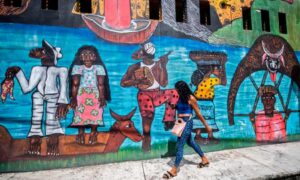
Angélica Sorrosa Alvarado is the curator, manager, tour guide, administrator, caretaker and cleaner at the Museo de las Culturas Afromestizas (Museum of Afro-Mexican Culture) in Cuajinicuilapa. “I am alone,” she says, gesturing at the cavernous halls of the museum, which she describes as “one of my proudest achievements”.
In the Costa Chica region, which is home to Mexico’s largest population of African-Mexicans, the museum is unique in the country. When it opened 25 years ago, it was heralded as recognition of the more than 2.5 million Afro-Mexicans in a country that had long overlooked them.
Now, however, the museum is now facing closure. Unpaid for 15 years and deserted by the founding committee who helped her create the space in 1999, Alvarado, 62, is fearful that she will soon have to retire. “They all left and now I am old and alone here,” she says.
Inside, painstakingly detailed dioramas depict white men flogging naked black figures, enslaved people who were brought to Mexico from Africa by the Spanish conquistadors in the 16th century. Etchings show hundreds of black people labouring in silver mines and plantations, and drawings show bodies hanging from wooden gallows.
As the exhibits move through the years towards the present day, a powerful and resistant identity emerges. Brightly coloured murals show Afro-Mexican cowboys on horseback next to flamboyant masks of devil-dancers, which symbolise slave resistance. There are paintings of Vincente Guerrero, Mexico’s second president. Guerrero, who was of African descent, abolished slavery in 1829 – 36 years before the US.
A physiotherapist, Alvarado fits in enough sessions to keep herself going financially while dedicating the rest of her time to keeping the museum going. But she feels defeated. With one hand on her chest, she says she regularly struggles to breathe after sweeping the floor and cleaning the exhibits of the dust that blows in from the street. The physical work makes her “bones and muscles ache throughout the night”.
“I don’t have people supporting me in this fight,” says Alvarado. “When we opened here, we had 10 people working in paid positions and I couldn’t even imagine the museum shutting. Today, I don’t think it can stay open.”
